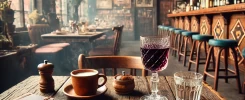There is a rhythm to movement, an ebb and flow that dictates when to stay and when to leave. Often, it isn’t about logic or planning, but about an internal pull. The feeling that a place has given all it has to offer, that it’s time to pack up and drift toward something new. Time itself becomes malleable in this lifestyle, stretching and contracting depending on the moment. Some places grip you longer than expected, others are mere waypoints, holding no deeper connection.
Traveling slowly teaches patience. It removes the urgency of the itinerary and replaces it with curiosity. The world unfolds differently when you are not rushing through it. A street corner can become a universe, a café can hold an entire afternoon of conversations, and a simple morning routine—like drinking a fresh juice—can become a ritual that grounds you in the present. There is no final destination, only the series of places that, for a time, feel like home.
Sometimes, boredom creeps in. The mind, accustomed to the overstimulation of modern life, begins to seek distractions. But boredom is a lie. It is not the absence of things to do but rather the absence of intention. The world is vast, full of skills to learn, conversations to have, and details to notice. A person who juggles never complains of having empty hands. A writer never complains of having nothing to say. Learning to sit with stillness, to let curiosity lead instead of external schedules, is the essence of freedom.
to walk and hickhikeg for hours, sometimes for a full day. The trick is to surrender. Sleeplessness the night before helps, ensuring that exhaustion takes over once seated. The motion lulls, the body adapts. The journey itself becomes the experience. The need to reach somewhere fades in importance when movement becomes the goal.
Weather dictates more than maps. The plan may be to visit Guatemala, but if the rain falls too heavily, it can wait. There is no need to chase discomfort when warmth and familiarity still linger nearby. Plans are not rigid; they breathe, shift, and evolve.
Conversations along the way create a mosaic of perspectives. Each person encountered holds a piece of insight—sometimes fleeting, sometimes profound. Some are passing characters, others leave lasting marks. A name remembered, a shared drink, a suggestion given at the right moment—these shape the journey as much as the landscape.
The issue of safety varies with location. In some places, the presence of law enforcement is a comfort; in others, it is a warning. Understanding the unspoken rules of a place, blending in rather than standing out, and knowing when to be cautious are essential skills. There are places where certain risks are not worth taking, where trusting intuition is the best compass.
Juices, fresh and vibrant, carry the essence of a place. In the early morning, a simple combination of carrot, beetroot, and orange can become a source of renewal. A green juice, perfectly blended, can taste like nothing else before. These small indulgences matter. They connect the traveler to the rhythm of the land, the people, the simple pleasures that define a culture.
Nomadism does not reject stability—it redefines it. Stability is not a fixed location but a mindset. The ability to find home in any corner of the world, to adapt without losing oneself, is the true skill. It is not about escape but about engagement. Not running from something, but moving toward something greater, even if undefined.
And yet, even in constant movement, the past lingers. Scars, whether on the body or the mind, travel with you. They shape how places are seen, how interactions unfold. They are not burdens but markers of experience, tattoos of memory etched deeper than ink.
A traveler’s greatest tool is not a map or a guidebook but the willingness to listen—to the world, to strangers, to oneself. Every conversation is a story, every new place an unwritten chapter. The journey does not end at a destination; it continues in the way stories are told, in the way experiences shape perspective, in the understanding that movement itself is the purpose.
References
- Bourdieu, P. (1984). Distinction: A social critique of the judgement of taste. Harvard University Press.
- De Botton, A. (2002). The art of travel. Pantheon.
- MacCannell, D. (1999). The tourist: A new theory of the leisure class. University of California Press.
- Solnit, R. (2000). Wanderlust: A history of walking. Penguin Books.
- Tuan, Y.-F. (1977). Space and place: The perspective of experience. University of Minnesota Press.

